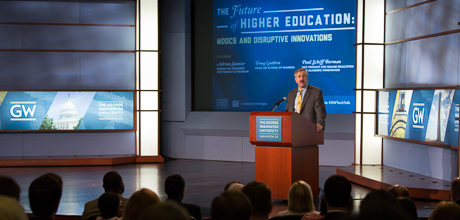Taking a “measured but participatory” approach, the George Washington University will work toward creating a handful of massive open online courses, or MOOCs, “that really showcase the things that make our university special,” Provost Steven Lerman said April 12.
In opening remarks at “The Future of Higher Education: MOOCs and Disruptive Innovations,” Dr. Lerman said MOOCs—courses that many universities across the world are hosting for free for anyone with an Internet connection—have the ability to add to, not endanger, the current higher education landscape.
“They’re not threats; they’re opportunities for us,” said Dr. Lerman, adding that creating MOOCs also forces the university to think about what differentiates taking a collection of MOOCs from a comprehensive, residentially based education.
The discussion, in front of a full house at Jack Morton Auditorium and hosted by the Department of Academic Technologies, also featured Doug Guthrie, dean of the School of Business; Paul Schiff Berman, vice provost for online education and academic innovation; and Adrian Sannier, senior vice president for product at Pearson, an education company.
Dr. Guthrie said he doesn’t support MOOCs in their current form, arguing online education needs to be interactive, build community and be customizable, like the School of Business’s “Digital Community.”
Interactivity “has to be part of the educational experience,” Dr. Guthrie said, meaning courses must be smaller—40 people instead of the 100,000 or more enrolled in some MOOCs—so professors can connect with the students, and so they can connect with each other. Customization, meanwhile, involves using data to understanding each student’s strengths and weaknesses and tweaking his or her virtual classroom experience.
Programs like those in the School of Business show that “online is not just about MOOCs,” Mr. Berman said. And whatever MOOCs are right now, it’s not what they’re eventually going to be, he added.
“It’s going to get a lot better,” Mr. Berman said.
MOOCs do provide an important access function, Mr. Berman noted. They are an opportunity for many people to receive education to which they may not have had access due to money or location.
In his keynote address, Dr. Sannier agreed that MOOCs haven’t yet reached a level of high interactivity. The current “one teacher, many students” model needs to change to one centered on the student and featuring a support system of tutors and study groups, he said.
Dr. Sannier also agreed with Dr. Guthrie about the importance of customization, or personalization, as he deemed it.
By gathering a massive amount of data on a global scale, such as how long it takes a student to answer a math question or which part of the equation he or she isn’t understanding, courses could become highly personalized.
It’s a big opportunity for learning, but with it comes some “scary pieces,” Dr. Sannier said.
Gathering this data essentially means students are always being watched, and some may not want a professor to have immediate access to information that shows their every weakness, particularly when it comes time to ask for a reference. It also might skew education too much toward quantitative, rather than qualitative, outcomes, he said.
Ultimately, few answers are known about the future of MOOCs and their place in higher education. But, said P.B. Garrett, associate provost and chief academic technology officer, in her opening remarks: It’s clear “something is going on.”


